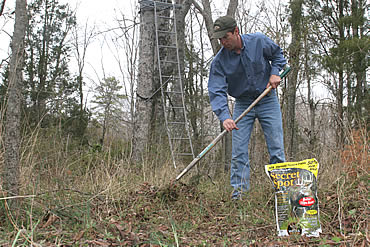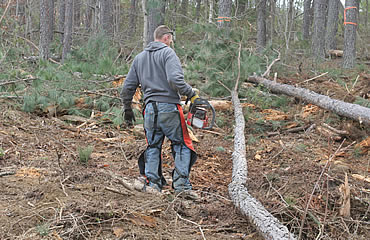Food plots take time, effort and money to do them right.
You spent hundreds of dollars on chemicals, fertilizer and seed, not to mention countless hours turning dirt on your ATV. But there you are, staring at a mess that was supposed to be your deer hunting honey hole. It might be a few skimpy clumps of clover swallowed by a sea of weeds, or it could be a patch of dirt with a scattering of yellow brassica plants poking up through the parched ground. Whatever it is, your food plots suck. So what went wrong? And more important, what can you do about it?
MISTAKE NUMBER ONE
“The biggest mistake I see, hands down, is not getting a soil test,” says Whitetail Institute Vice President Steve Scott. “It can mean the difference between success and total failure.”
John Carpenter, Pennington Seed national sales manager, agrees. “Probably half the people don’t even do a soil test,” he said. “A soil test is one of the most important, easiest and least expensive steps to a successful plot. When you consider the amount of time and money you invest in a food plot, it just doesn’t make sense not to do one.”
Not only will a soil test tell you exactly what fertilizer and lime application rates your food plots need, it will likely save you money, and lots of it, in the long run. Whether you utilize the services of your local agriculture extension office or a private company like Whitetail Institute, a soil test can prevent you from using too much fertilizer or, more specifically, the wrong fertilizer. Instead of buying a couple of bags of lime and some 10-10-10 under the assumption that any fertilizer is better than no fertilizer, a soil test will pinpoint your plot’s specific needs.
As with any procedure, it’s vital to follow the instructions in order to get a reliable test. Carpenter says a proper soil sample should include dirt from at least five areas of each food plot. He recommends taking soil from the four corners and the middle of each plot.
“You also want to take soil from the same depth as the roots instead of scraping the surface,” he said. “I recommend digging down between 1 and 6 inches.”
 DON’T WAIT
DON’T WAIT
Procrastination is another recipe for failure. A soil test is a simple, inexpensive step, but it needs to be done several months before planting time.
Scott says too many hunters wait until planting conditions are prime before they even start working the soil. By then, it might be too late to plant anything because it can take several weeks to prepare the bed properly. Seed that goes in too late in the spring might not have time to develop enough root structure to withstand the withering heat common in the summer.
Wait too long to put down a fall plot, and the plants might not have enough time to fully mature. Some plants take 45 days or more to reach maturity. Traditional pelletized lime needs to be spread well in advance of planting because it can take up to six months to neutralize acidic soil.
“That’s one reason we recommend conducting a soil test well before you start preparing the bed for seed,” says Scott.
There is good news for procrastinators, however, thanks to a new product called Fast Acting Lime. It can be applied with a spreader and begins raising pH immediately.
If you find yourself in the majority of planters who wait too long to address soil pH issues, this product can make the difference between success and failure.
There is a fine line between planting too early and too late, but starting the preliminary steps well before you spread any seed is one key to a successful food plot. If you aren’t sure, read the planting dates on the seed bag and plan your prep work with those dates in mind, even if it seems too hot or too cold to get started.
BEYOND YOUR CONTROL
As with any cultivated crop, plants like clover, peas or brassicas can be sensitive to various environmental factors that can’t be controlled. The most obvious, and likely the most harmful, is a lack of rain. Virtually every corner of whitetail country has been hit with a spell of dry weather in the last decade, with many regions suffering an extended drought that has not only withered crops, but also wreaked havoc on food plots. Short of irrigating food plots, there isn’t much you can do to cure that.
There are some alternatives, though. Instead of relying on plants that are sensitive to low soil moisture levels, consider an entirely new food plot plant, something that is better suited to dry conditions. A great example is alfalfa, a deep-rooted plant that withstands dry weather much better than clover. It’s a perennial plant that will go dormant during dry spells but bounces back with a little rain.
Clover can withstand a little dry weather, too, but it can’t handle a prolonged drought. Chicory, another deep-rooted perennial, also holds up better in dry soil. Whatever you choose, make sure you use seeds designed for the food plot market.
 WRONG PLACE
WRONG PLACE
While no one can control rainfall, food plotters can give their plots a starting chance before they drop the first seed, says Carpenter.
“One of the biggest reasons I see food plots fail is because of improper site selection. People try to use the right seed in the wrong place, or they simply try to put a food plot where it won’t grow well in the first place,” he says.
Even if your region gets a normal amount of rain, some plants, like clover, simply won’t perform in soil that doesn’t hold moisture well. It will, however, do well in moist soil typical of bottomland habitat.
But it still needs other ingredients to grow. All food plot plants need at least four hours of direct sunlight, although some plants are somewhat more shade tolerant. That’s why so many plots placed on logging roads or in a small openings in deep woods don’t meet expectations.
Carving out a corner of a field can result in failure because the corner might not get enough sunlight. The southeast corner, in particular, will get the least amount of sunlight, while the northwest corner will get the most.
The general rule is that trees surrounding a plot will shade the ground a third of their height away from their base. In other words, if the trees surrounding your plot are 100 feet high, expect 33 feet of dead space around the forest’s edge because of a lack of prolonged sunlight. That can mean smaller plots within a mature forest need to be well over 66 feet wide in order to succeed. There are plenty of variables with that rule, but it’s a good guideline, nonetheless.
The only real cure for a struggling deep-woods plot is to push over or cut down trees directly so the ground gets adequate sunlight.
But just as a plot can suffer from inadequate sun, it can burn up with too much direct sun during the summer. Consider using plants that can withstand hot, dry weather if your goal is to provide summer nutrition.
SPRAY IT
Even with the right seed choice, you’ll still be faced with the most common problem in any food plot: weeds. Unwanted plants not only rob your plots of moisture, they gobble up limited nutrients.
Dropping fertilizer on a weedy food plot might help the clover and beans, but it also feeds the weeds.
It’s virtually impossible to control every weed within a food plot, but it’s relatively easy to knock them down to manageable levels.
Routine mowing can help control annual weeds, but it won’t eliminate or even reduce troublesome grasses like fescue or Bermuda grass, which can overwhelm a patch of clover in a year or two. The only way to control grass and other pesky perennials is through a dose or two — or three — of a selective herbicide that kills specific types of plants. Some, like Whitetail Institute’s Arrest, kill grasses but don’t harm broadleaf plants like chicory or clover. Others are designed to kill broadleafs except clover and alfalfa.
WHEN GOOD ENOUGH IS GOOD ENOUGH
Herbicides aren’t cheap, though. How much time and money you spend in pursuit of food plot perfection is a question only you can answer. There’s nothing wrong with a few weeds growing in your plots. Many of the plants we call weeds are actually the same things deer have been eating before the very notion of planting a food plot was born.
But if a field choked with weeds doesn’t meet your definition of a quality food plot, take a step back and examine all the factors that contribute to success. It might be something simple, or it might be something well beyond your control.
Fix it if you can; leave it if you can’t. Sometimes, good enough is good enough. If your food plots suck, though, you’ll at least know why.
Read Recent Articles:
• Thank You, Dad: Timely invite salvages dream hunt for new father.
• School’s In Session: A Buckmasters member shares his method of success.
• Feed Your Herd: Reducing deer numbers is not the only way to balance deer with their habitat.
This article was published in the July 2012 edition of Buckmasters Whitetail Magazine. Subscribe today to have Buckmasters delivered to your home.